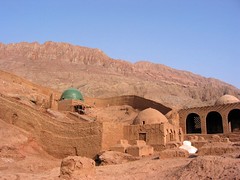 Boingboing linked to scans of a Japanese propaganda booklet for kids from the Japanese Imperial period. The low resolution of the scans (not to mention the old-fashioned katakana orthography) makes it a bit hard to read, but that hasn’t stopped two different bloggers from posting translations before I even saw it. Kyle Goetz and Paul Battley both have translations, but Paul Battley’s, in which he places the translation in captions around the original images, is far more readable. Kyle Goetz’s translation, which has more comments and translation notes, is recommended only for those who also know some Japanese. Kyle theorizes that the booklet was written for foreigners, but I believe it is quite clearly a children’s book.
Boingboing linked to scans of a Japanese propaganda booklet for kids from the Japanese Imperial period. The low resolution of the scans (not to mention the old-fashioned katakana orthography) makes it a bit hard to read, but that hasn’t stopped two different bloggers from posting translations before I even saw it. Kyle Goetz and Paul Battley both have translations, but Paul Battley’s, in which he places the translation in captions around the original images, is far more readable. Kyle Goetz’s translation, which has more comments and translation notes, is recommended only for those who also know some Japanese. Kyle theorizes that the booklet was written for foreigners, but I believe it is quite clearly a children’s book.
Unfortunately, the book seems to be undated, but from the cover we can see that it was published by Dai-Nihon Yuubenkai Kodansha (大日本雄弁会講談社). Anyone who has even a passing acquintance with Japanese media or publishing will probably recognize Kodansha, which is still a major publisher of magazines, comics and various types of books.
According to the history section of Kodansha’s English language site:
Seiji Noma, the founder of the company, published his first magazine, Yuben (Oratory) in 1909. This was followed in 1911 by Kodan Club, a monthly collection of kodan or traditional stories from which the company was to take its name. The success of Kodan Club assured the future of the new company and, by the mid-1930s, Kodansha had taken a leading position in the magazine publishing industry through the publication of nine magazines.
Looking at the timeline in the more detailed history section of their Japanese language website, we can see that Dai-Nihon Yuubenkai and it’s spinoff, Kodansha, were merged in 1925, creating a company with the combined name of Dai-Nihon Yuubenkai Kodansha. Since this remained the companies name until 1958 (when it became simply Kodansha Corporation) and this booklet is very much a product of the Imperial era, it must have been published between 1925 and 1945.
The Wikipedia article also contains a fun piece of trivia about Kodansha. Before World War II, the company attempted to branch out into other industries, marketting a nutritional beverage called Dorikono. However, due to a wartime sugar shortage, they were forced to cease production of the drink, and completely withdrew from the food industry.

